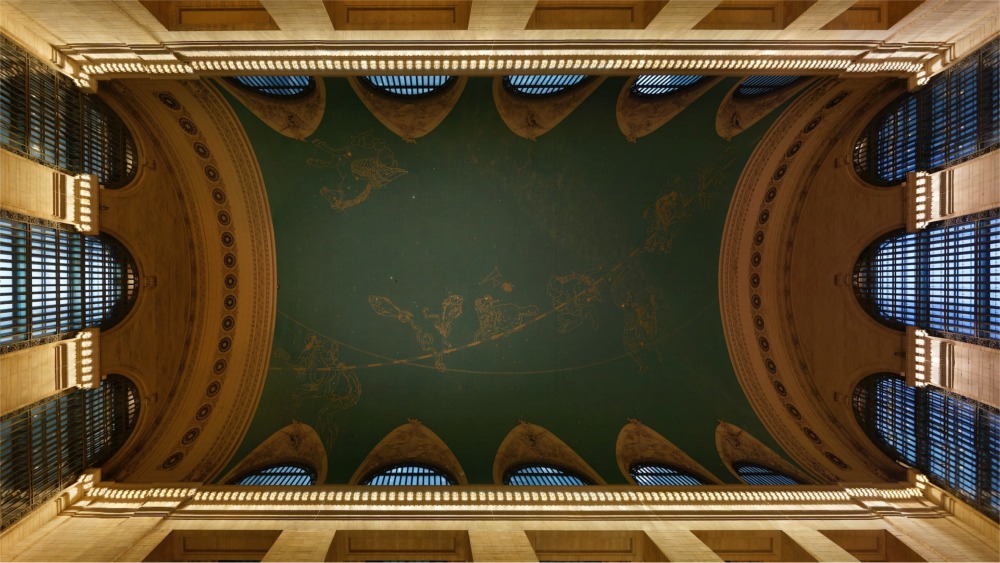Main Concourse Celestial Ceiling
Home > New York State Photographs > Grand Central Terminal > Celestial Ceiling

Main Concourse's Celestial Ceiling
The Main Concourse's ceiling is an elliptical barrel vault. A false ceiling of square boards, installed in 1944, bears an elaborate celestial mural painted with more than 2,500 stars and several bands in gold set against a turquoise backdrop. This ceiling covers the original 1913 version, which had degraded because of water damage.
Original plans called for the ceiling to contain a skylight, but money and time ran out. Instead, a mural was painted directly on the ceiling. It was conceived in 1912 by architect Warren and painter Paul César Helleu. The latter, who had come to the United States for a three-month stay to create portraits of eight women for a Parisian magazine, sketched a conceptual design for Warren. Helleu worked from a chart given by Columbia astronomy professor Harold Jacoby, who had derived it from the Uranometria, a star atlas published in 1603. The mural was executed in 1913 by James Monroe Hewlett and Charles Basing of Hewlett-Basing Studio. They were assisted in the design by Helleu and multiple astronomers, and in the painting by more than 50 painting assistants. Around 63 electric bulbs were installed to amplify the visual impact of the stars. The depicted constellations include those of the winter zodiac viewable from October to March, from Aquarius to Cancer. Also depicted are Pegasus, Triangulum Majus and Minus, Aries, Musca Borealis, and Orion, as well as two broad gold bands spanning the ceiling, representing the ecliptic and the equator.
By the 1920s, the roof began to leak, damaging the mural with water and mold. Over the next two decades, the mural "faded to a hue something like that of a khaki shirt overdosed with Navy blue". In August 1944, New York Central covered the original ceiling with 4-by-8-foot cement-and-asbestos boards and painted them in a facsimile of the original mural. Unveiled in June 1945, the new mural contained less astronomical detail; it also lacked light bulbs to mimic stars. The boards' outlines remain visible today.
Constellation of Cancer pointing toward the uncleaned ceiling patch.By the 1980s, the new ceiling was obscured by decades of grime. The dirt buildup was sometimes reported to be tar and nicotine from tobacco smoke, or diesel or coal soot from the trains in the terminal's train shed (trains have utilized electric power in Manhattan since 1908). Spectroscopic examination revealed that it was made up of air pollutants from trucks, cars, and emissions and contaminants from incinerators and factories. As a general renovation of the terminal got underway, historians and preservationists called for the 1944 boards to be removed and the original ceiling mural restored. But Beyer Blinder Belle, the architecture firm that led the renovation, deemed the original mural irreversibly damaged and noted that the asbestos-laden boards would be hazardous to remove. So, starting in September 1996, the ceiling boards were cleaned and repainted. Lights were installed into the ceiling boards to imitate the stars, restoring a feature previously only seen from 1913 to 1944. A single dark patch near the crab constellation (representing Cancer) was left untouched by renovators to remind visitors of the grime that once covered the ceiling.
The ceiling bears a small dark circle amid the stars above the image of Pisces. In a 1957 attempt to improve public morale after the Soviet Union launched Sputnik, an American Redstone missile was set up in the Main Concourse. With no other way to erect the missile, a hole was cut into the 1944 false ceiling to allow a cable to be lowered to lift the rocket into place. Historical preservation dictated that this hole remain as a reminder of the many uses of the Terminal over the years.
The starry ceiling contains several astronomical inaccuracies. While the stars within some constellations appear correctly as they would from earth, other constellations are reversed left-to-right, as is the overall arrangement of the constellations on the ceiling. For example, Orion is correctly rendered, but the adjacent constellations Taurus and Gemini are reversed both internally and in their relation to Orion, with Taurus near Orion's raised arm where Gemini should be. There are various explanations that are often given for this error. One possible explanation is that the overall ceiling design might have been based on the medieval custom of depicting the sky as it would appear to God looking in at the celestial sphere from outside, but that would have reversed Orion as well. A more likely explanation is partially mistaken transcription of the sketch supplied by Harold Jacoby, the explanation Jacoby gave when the issue was brought to him. Jacoby surmised that Basing had placed the sketch at his feet, rather than holding it up toward the ceiling, when copying its details. Though the astronomical inconsistencies were noticed promptly by a commuter within a month of the station's opening, they have not been corrected in any of the subsequent renovations of the ceiling.
From Wikipedia, the free encyclopedia.


